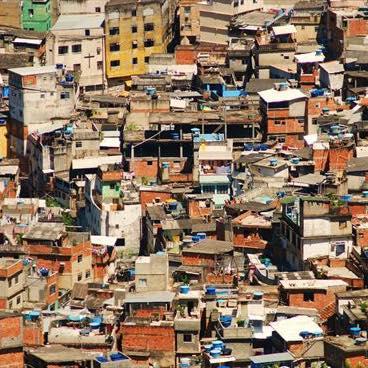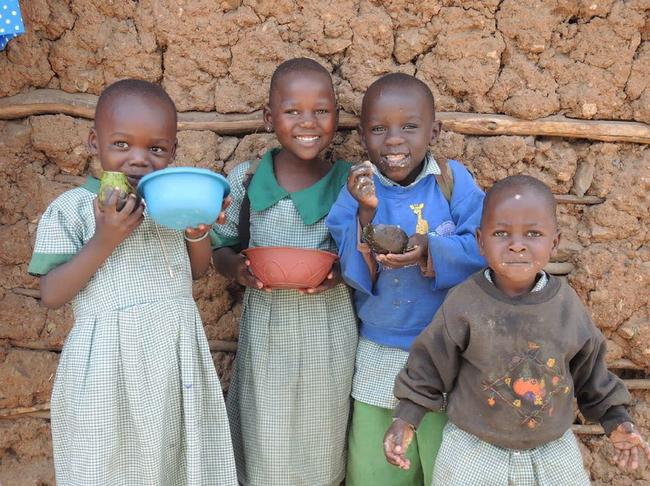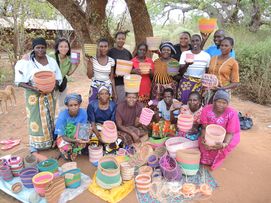The beauty of Kenya Slum
Project by : Chan Kam Lun
Kenya Service Trip 2017
8591 km is the distance between Hong Kong and Kenya. Could you imagine that people outside the 8591 km how to live a life? Most of the people living in slums are low-income earners with a per capita income of less than $ 1.9 a day below the international poverty line. They also encountered many difficulties. In addition to difficult for affording living cost, suffering from exploitation, there are no clean water, the lack of sanitation, and living in the simple and crude house. As a result, children need to earn life expenses because of the hard at family. Ultimately, they cannot complete the study and they are no knowledge and skills, so that the outlook they can choose is very limited.
Basic knowledge and skills in Hong Kong, such as basic computer book processing, basic computer operations are very popular. However, those learning cost in Kenya is a major decision whether the family's life is full of food and clothing or not. A group of volunteer of youngsters will live in Kenya from 27 July to 7 August 2017. A sustainable community center will be established in the Kenya’s second largest slum, Mathare Valley, for improving their living conditions. At the same time, it is hoped that the people of Hong Kong will pay attention to Kenya so that if they cannot go with us, they can also contribute their helping to the people in need.
Introduction
Education in Hong Kong
In Hong Kong, every child can receive 12 years of free education. According to the statistics on the number of students in the 2015/16 annual report of the Education Bureau, the number of primary schools in Hong Kong is 337,558 and the number of secondary schools is 352 609. The literacy rate in Hong Kong has been getting closer to 100%
Education in Kenya
According to a survey conducted by the United Nations Educational, Scientific and Cultural Organization (UNESCO) at the United Nations Educational, Scientific and Cultural Organization (UNESCO) for UNESCO for the United Nations Educational, Scientific and Cultural Organization (UNESCO), Kenya has a literacy rate of 78 per cent over 15 years of age. This means that 10.31 million people are illiterate among the 465 million (2015 population). And this 10.13 million people is living in the lowest level in Kenya. With Africa's largest slum, Kibera, it is only a few minutes away from the heart of the capital city of Nairobi, where the unemployment rate is as high as 50%. (What is the main reasons? A lack of knowledge and skills)
Poor slum dwellers only eat a meal a day. No money is available for their children to go to school. Their children would face the problem of unemployment, causing serious cross-generation poverty while they are growing up and a lack of knowledge and skills. According to the Kenya Ministry of Education statistics, there are currently more than 1 million children due to poverty out of school. 9 children out of every 10 poor families cannot complete primary school. The rate of girls out of school is 50%, so this is why they cherish every opportunity of leaning.
To break the intergenerational poverty in slum, it is an important to raise the knowledge and skills of slum youths to increase their employment opportunities and to improve the economic situation of the family for achieving the goal of poverty alleviation. We hope provide different learning opportunities in a sustainable community center for slums including basic computer book processing (Microsoft Office) and sewing skills. We also set up a small shop, so that young people can learn small business skills. Besides, a toy library will be set up for the slum kids to enjoy playing with toys safely.
Project Proponent
The project proponent is a volunteer group of IVE (Tsing Yi) students from different departments, hoping to apply the knowledge they have learned to help the needy.
Purpose of fundraising
Hong Kong's dollar is equal to $ 13 for Kenya, and through our volunteer group, a small contribution from Hong Kong people can be assembled to build a sustainable community center for Kenya slums. they can improve their life skills from which. All the money raised will be used to build the infrastructure of the community center, such as the purchase of sewing machines, chairs, stationery, small shops of the first batch of goods, etc., it will also be used to set up the power supply system.
The Service List of Community Center (Initial Stage)
- Fundamental computer book processing (Microsoft Office)
- Sewing skills
- Toy library
- Small Shop:i) cheap copy and print service
ii) cheap groceries such as rice, oil and cleaning supplies
Operation of Community Center
The first phase of the community center will be located in one of the slums of primary school, Caso Upendo Primary School. We will provide the training about the basic knowledge of computer for teachers and mature students. they thus become the first batch tutor. At the same time, 2-3 local college students will be invited to volunteer to form a mentor team with trained teachers to provide computer basic knowledge courses to slum youths.
Sewing skills will be taught by local teachers
The toy library will be managed by the school teacher and opened to the slum children after school
Hiring slums for sale and loan agents in the small shop, school teachers are responsible for the supervision and financial management. Also, it will recruit slums of young as interns for learning the operation as the store.
In addition, it is recommended that the center provide some activities to attract young people and children to participate in the community center
Schedule
Five year’s planning
As a result of the establishment of a vocational skill promotion center is a long-term plan.
We have a five-year plan to implement this plan.
|
Time |
Planning |
Money used |
|
7/2017 |
- We would tell the locals about the purpose, content and timetable of our plan in first arrive.
- For the first time, it is going to build general basic equipment, such as materials collected in advance: computers, printers, photocopiers, toys, books ... At the same time, to hire local people for the administrator and local college students as part-time Teachers together with us set some rules of use .- Finally, it is time to promote the function of the center with the long-term development of everyone's shadow. |
First year goal As the vocational skills promotion center may not necessarily be widely recognized by the local residents, and the local residents cannot often use it. We expect the first year may not be able to achieve the break even. So, the initial working capital is supported by the first fundraising. |
|
2018 |
Into the second year, I believe the locals will start to use the central facilities and feel the skills helping them for finding a job. It is because there are some graduates have been put into social work, there is a good example for publicity. |
The center should achieve a break even now, but we also keep doing fundraising activities for the development center and make the backup funds. |
|
2019 |
- The center will begin to break even in this year. If the funds are abundant, the center's facilities will be improved. Since some of the infrastructure in the first year including computers and the printer would be damaged, purchase new or re-collected in Hong Kong,。 - Also, we consider setting up new skills’ teaching and planning to expand the center. - Rent or buy the property near slums as permanent place for community center. |
In the third year, we will be based on the operation of the center, whether to maintain the balance of payments, and decide whether to raise funds or not. |
|
2020 |
- I believe that today, four years later, they will have a stable job, so that the inhabitants of the slums of Kenya can improve their life, and break the intergenerational poverty.
- In terms of operations, I believe that the center will achieve a break even, and there are low profits. |
No need for fundraising |
|
2021 |
The operation and development of the center has gone to a mature stage and does not depend on Hong Kong's contributions. The center can be independent in according to their ideas and development. Hoping to let the center to be developed in other places in Kenya. |
No need for fundraising |
Budget
|
Expenditure items |
Amount (HK $) |
|
|
1 |
Setup the power supply system |
10,000 |
|
2 |
Buy chairs and tables |
2,500 |
|
3 |
Purchase the first batch of goods in small shops |
9,000 |
|
4 |
Hire a salesman |
5,000(First Year) |
|
5 |
Alter the classroom to be a shop |
6,000 |
|
6 |
Buy a printer |
500 |
|
7 |
Buy Print inks |
2,000(First Year) |
|
8 |
Fee of electricity |
3,000(First Year) |
|
9 |
Stationery and paper |
2,000(First Year) |
|
Total: |
40,000 |
|


C
HK$100
(approximately US$13*)
當地小朋友親自繪製明信片一張並會從肯亞郵寄到你的家!
HK$500
(approximately US$65*)

當地小朋友親自繪製明信片一張及他們親手製作的手鏈,上面還有你的名字
明信片會從肯亞郵寄到你的家!
HK$1,000
(approximately US$129*)

當地小朋友親自繪製明信片一張及農村婦女用全天然有機植物纖維親手製作的精美實用籃子一個。
明信片會從肯亞郵寄到你的家!
Contribute any amount
- We welcome any pledge amount. Thank you for supporting the project without any rewards.

